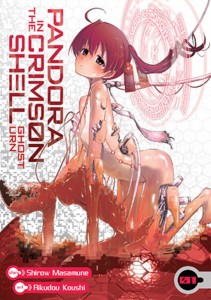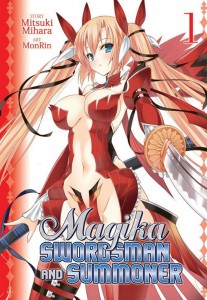Pandora in the Crimson Shell: Ghost Urn by Shirow Masamune and Rikudou Koushi. Released in Japan as “Koukaku no Pandora – Ghost Urn” by Kadokawa Shoten, serialization ongoing in the magazine Newtype A. Magika: Swordsman and Summoner by Mitsuki Mihara and MonRin. Released in Japan as “Magika no Kenshi to Shoukan Maou” by Media Factory, serialization ongoing in the magazine Comic Alive. Released in North America by Seven Seas.
As I’ve said before, my tendency to give all Volume 1’s a shot even if I suspect they won’t be my thing at all gets me into a lot of difficulties, particularly with Seven Seas, which is very much an all or nothing company with me. They debuted two new titles this month, one of which not only has the amazing writer-artist team of Shirow Masamune and Rikudou Koushi (leaving Viz means he gets his u’s back), but managed to be on SDCC’s worst manga of the year list despite having been out a total of 5 days when the panel ran. The other one is a harem fantasy from my old nemesis, Comic Alive. Two otaku-pandering titles enter, only one can leave – which one did I like more?
Pandora gets off to a poor start with that cover, featuring our heroine bursting, semi-mude, from some sort of mosaiced plastic casing. We then get color pages of another heroine dressing up in tiny lingerie. This title definitely does not skimp on the fanservice, as we’ll see throughout the volume. The basic premise involves Nene, our heroine, getting involved with a confident young woman who may actually be a supervillain and her cyborg companion. Nene is also a cyborg and highly idealistic, saying that she wants to see world peace. Sadly, she arrives at her island destination to find a robot gone amok, and only she and Clarion (the other cyborg) can hope to stop it.
On pure skeeze factor, Pandora in the Crimson Shell wins hands down. The sequences where Nene has to finger Clarion in her vaginal ‘port’ are risible, though admittedly I wouldn’t put it past Shirow based on past titles. Speaking of which, the credits show quite a committee working on this title. Rikudou is the main artist in charge, but I had felt that I could only see his art style occasionally, and that may be why. His sense of humor, thankfully, is sometimes more apparent, particularly in the Excel-ish intrepid reporter and the dry tones of Uzal Delilah. The action sequences, which make up much of the second half, are… decent. Basically, if it weren’t for the horrible service and constant sexual assault hints, I may actually have enjoyed this. Sadly, the service and assault is all over the book.
Magika Swordsman and Summoner is our second title, and reads like a modern-day light novel checklist (appropriate, it’s based on a light novel). Our hero is the lowest of his class at magic school, not good for much yet but stirring water around. He’s also the only male in a class of females. He has an adopted sister (older than him, but acts younger as they only found that out recently), who harbors incestuous feelings for him. At the school, he meets a busty airheaded woman who turns out to be student council president, as well as an angry young blonde who seems very upset that he doesn’t recognize her, for some reason. Oh yes, you can also add in a quiet, stoic elf-girl and a shy girl who can’t deal with men. When he summons an amnesiac diva with no powers (which gets him in trouble, as she may be evil), he discovers he has to form a harem of 72 women in order to become the Harem King.
If you started throwing up halfway through that, you may get the feeling I had while reading this title. Everything about it is from Tropes 101, be it the Magic Academy stuff or the Harem stuff, though I admit 72 is aiming high – even Negima didn’t quite go for that many women. (Yes, it’s from reports of the houris that accompany Muslim martyrs after they die.) Seven Seas’ back cover notes that fans of Dragonar Academy and Zero’s Familiar will enjoy it, and I can’t argue with that – it’s certainly more of the same. The one redeeming feature is the hero, who seems a decent sort and is very uncomfortable with the whole harem concept. We’ll see how long that lasts. Or rather, other readers will.
In general, if you’re going to be a bad manga and keep me interested, it’s best to do it with style. Neither of these titles are things I’d recommend to anyone except SS’s core otaku audience. But honestly, Ghost Urn made me wonder how the cliffhanger might be resolved, whereas with S&S I just didn’t care. On balance, I have to give the edge to Shirow, Rikudou and company here.


